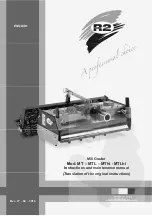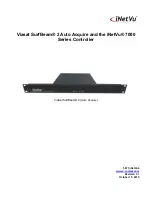
7
SHOCKWAVE ICE is designed to mitigate shock and
vibration encountered in high speed vessel operation on
rough seas. Following the suggestions in this section will
ensure that you are getting the most out of the product.
SET THE RIDE HEIGHT
The suspension must be allowed to compress and extend
as designed. Ensure the ICE is SET after each time the
payload on the ICE changes. This should allow the ICE to
sit 2” [50mm] less than full shock extension.
OPERATE IN THE VESSEL’S DESIGN ENVELOPE
Driving the boat beyond its limitations can have damaging
effects on the hull, engines and equipment. The SHOCK-
WAVE ICE is designed to provide shock mitigation to the
occupants. It will not protect the occupants from injury
caused from operating the vessel outside of its operational
envelope.
OPERATE THE VESSEL IN YOUR CREWS PHYSICAL
CONDITIONING ENVELOPE
Personal fitness is a limiting factor to the amount of sus-
tained G loads a person can endure without injury. If you
have inexperienced, relatively unfit or overweight per-
sons aboard, extra caution must be exercised to prevent
injury. The helmsman must be keenly aware of the shock
loads being transmitted to passengers not in the ICE or
standing, as serious injury can occur. Installation of the
SHOCKWAVE ICE provides an extra level of protection, but
the ICE will not protect a person from ALL shock loads.
OPERATE IN YOUR OWN ABILITY ENVELOPE
The SHOCKWAVE ICE will increase the confidence of
the helmsman. Overconfidence can lead to loss of boat
control. Generally, the ICE will permit greater control of
the vessel and the helmsman should focus on using the
control advantages of the shock mitigated ICE to better
look after the vessel and crew.
DO NOT TIE THE BOAT UP WITH THE ICE
As tempting as it may be, the SHOCKWAVE ICE is not
designed to tie up the boat.
ENSURE THAT THE ICE IS FUNCTIONING PROPERLY
Refer to the Caution Notes in the preceding sections.
The following is provided as a general checklist.
Do not operate the ICE if:
• The shock ride height is incorrect.
• Any components are loose, broken or missing.
• The ICE makes a strange noise when being operated.
USE SEAT BELTS – IF SUPPLIED
Seat belts prevent occupants from being ejected from the
vessel and the seat. When not in use, the seat belt buckle
clasp should be fastened to prevent damage to the ICE.
SET FORE AND AFT SEAT ADJUST CORRECTLY – IF
SUPPLIED
Correct ergonomics and posture enhance the ability to
operate the vessel safely and reduces the risk of shock
and vibration related injury. Take the time to adjust the
seat so that it is comfortable.
DO NOT SIT IN SEATS WITH HARD OR SHARP
OBJECTS. DO NOT WALK ON SEATS
Ensure that sharp objects and heavy gear are worn so that
they will not tear the upholstery.
RINSE ICE WITH FRESH WATER AFTER EACH USE
Rinse the ICE and the seats with fresh water after each
use, or every week if being stored outside, to prevent a
buildup of salt and debris.
COVER SEATS WHEN NOT IN USE
Seat covers are available from SHOCKWAVE to cover all
the seats.
TIE EVERYTHING DOWN
Pay attention to how you have stowed your gear. Elastic
shock cords and ratchet tie downs should be used to
secure all gear. Plastic containers of oil and other fluids
must be protected from chafing and puncture. Electronic
equipment must be secured to prevent damage from
shock loads.
CHECK ALL EQUIPMENT
Conventional mounting brackets for heavy items such as
fire extinguishers are subject to much more loading than
without shock mitigation. Make sure all your equipment
brackets are tight. Recheck major equipment bolts reg-
ularly. Wiring, cables and fluid hoses should be bundled
tightly and not allowed to flail. Do not allow any objects
under the ICE. The objects will limit the stroke of the ICE
and damage the objects or damage the ICE.
REMOVE OR PAD BODY STRIKE HAZARDS
Hard objects, particularly in the head strike zone, need to
be rounded and padded. When assessing your body strike
hazards consider a generous portion of clearance, as the
body will stretch in a high G situation.
UNDERSTANDING THE BASICS
UNDERSTANDING THE BASICS








































